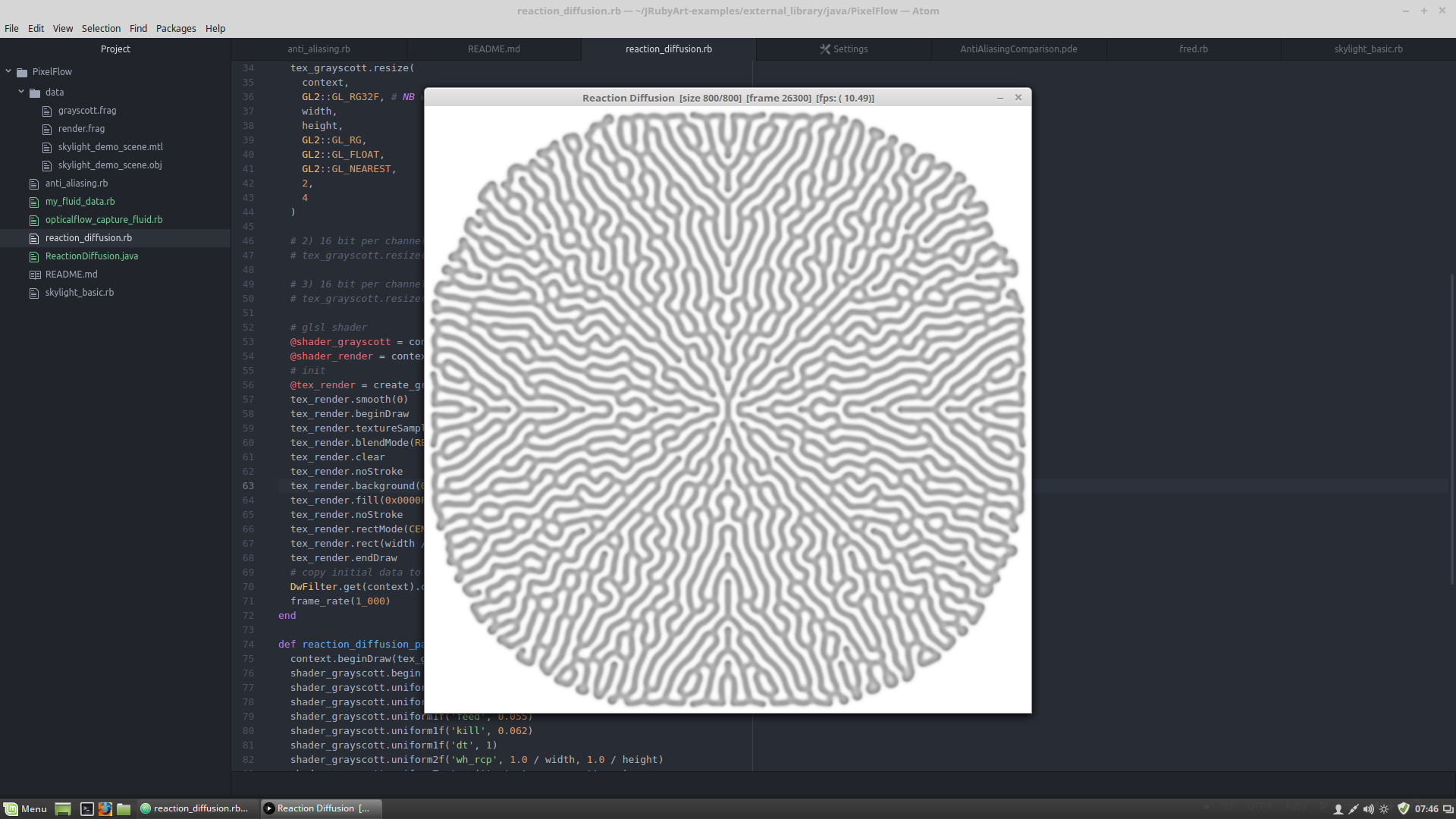Reaction Diffusion with PixelFlow in JRubyArt
Thomas Diewald is a prolific graphics programmer in Java, Javascript, OpenGL/WebGL, GLSL, OpenCL, C++, C. He has developed a number of libraries for vanilla processing, and we explore their use in JRubyArt and propane (actually we barely scratch the surface) in this and in recent previous posts, but hope that we can provide inspiration for others to follow.
PixelFlow library
A Processing/Java library for high performance GPU-Computing (GLSL). See PixelFlow library on github and the PixelFlow website.
Here an example sketch translated for JRubyArt for the sketch to run you need install the PixelFlow libraries using the processing ide, I suppose there could be a possibility of a gem like toxiclibs which also has reaction diffusion examples:-
load_library :PixelFlow
# PixelFlow | Copyright (C) 2016 Thomas Diewald - http://thomasdiewald.com
# translated to JRubyArt by Martin Prout
# A Processing/Java library for high performance GPU-Computing (GLSL).
# MIT License: https://opensource.org/licenses/MIT
module Reaction
java_import 'com.thomasdiewald.pixelflow.java.DwPixelFlow'
java_import 'com.thomasdiewald.pixelflow.java.dwgl.DwGLSLProgram'
java_import 'com.thomasdiewald.pixelflow.java.dwgl.DwGLTexture'
java_import 'com.thomasdiewald.pixelflow.java.imageprocessing.filter.DwFilter'
java_import 'com.jogamp.opengl.GL2'
end
include Reaction
# reaction-diffusion, grayscott
#
# using custom shaders/textures for fast multipass rendering.
attr_reader :context, :tex_grayscott, :shader_grayscott, :shader_render
attr_reader :pass, :tex_render
def settings
size(800, 800, P2D)
smooth(0)
end
def setup
# multipass rendering texture
@tex_grayscott = DwGLTexture::TexturePingPong.new
# pixelflow context
@context = DwPixelFlow.new(self)
@pass = 0
# 1) 32 bit per channel
tex_grayscott.resize(
context,
GL2::GL_RG32F, # NB we need :: not . here to access constant
width,
height,
GL2::GL_RG,
GL2::GL_FLOAT,
GL2::GL_NEAREST,
2,
4
)
# 2) 16 bit per channel, lack of precision is obvious in the result, its fast though
# tex_grayscott.resize(context, GL2::GL_RG16F, width, height, GL2::GL_RG, GL2::GL_FLOAT, GL2::GL_NEAREST, 2, 2)
# 3) 16 bit per channel, better than 2)
# tex_grayscott.resize(context, GL2::GL_RG16_SNORM, width, height, GL2::GL_RG, GL2::GL_FLOAT, GL2::GL_NEAREST, 2, 2)
# glsl shader
@shader_grayscott = context.createShader(data_path('grayscott.frag'))
@shader_render = context.createShader(data_path('render.frag'))
# init
@tex_render = create_graphics(width, height, P2D)
tex_render.smooth(0)
tex_render.beginDraw
tex_render.textureSampling(2)
tex_render.blendMode(REPLACE)
tex_render.clear
tex_render.noStroke
tex_render.background(0x00FF0000) # NB: we can use hexadecimal in ruby
tex_render.fill(0x0000FF00)
tex_render.noStroke
tex_render.rectMode(CENTER)
tex_render.rect(width / 2, height / 2, 20, 20)
tex_render.endDraw
# copy initial data to source texture
DwFilter.get(context).copy.apply(tex_render, tex_grayscott.src)
frame_rate(1_000)
end
def reaction_diffusion_pass
context.beginDraw(tex_grayscott.dst)
shader_grayscott.begin
shader_grayscott.uniform1f('dA', 1.0)
shader_grayscott.uniform1f('dB', 0.5)
shader_grayscott.uniform1f('feed', 0.055)
shader_grayscott.uniform1f('kill', 0.062)
shader_grayscott.uniform1f('dt', 1)
shader_grayscott.uniform2f('wh_rcp', 1.0 / width, 1.0 / height)
shader_grayscott.uniformTexture('tex', tex_grayscott.src)
shader_grayscott.drawFullScreenQuad
shader_grayscott.end
context.endDraw('reaction_diffusion_pass')
tex_grayscott.swap
@pass += 1
end
def draw
# multipass rendering, ping-pong
context.begin
100.times { reaction_diffusion_pass }
# create display texture
context.beginDraw(tex_render)
shader_render.begin
shader_render.uniform2f('wh_rcp', 1.0 / width, 1.0 / height)
shader_render.uniformTexture('tex', tex_grayscott.src)
shader_render.drawFullScreenQuad
shader_render.end
context.endDraw('render')
context.end
# put it on the screen
blendMode(REPLACE)
image(tex_render, 0, 0)
save_frame(data_path('grayscott1.jpg')) if frame_count == 1_000
format_string = 'Reaction Diffusion [size %d/%d] [frame %d] [fps: (%6.2f)]'
surface.set_title(format(format_string, width, height, pass, frame_rate))
end
snapshot of the running sketch from atom
